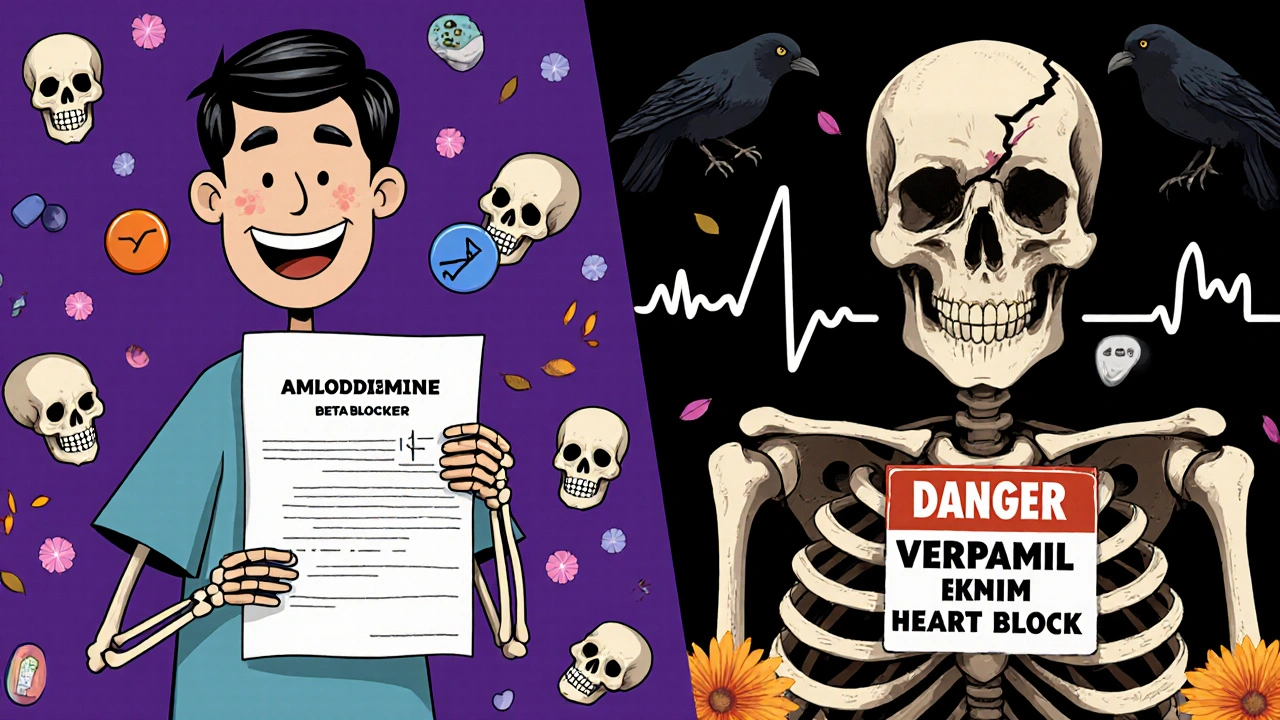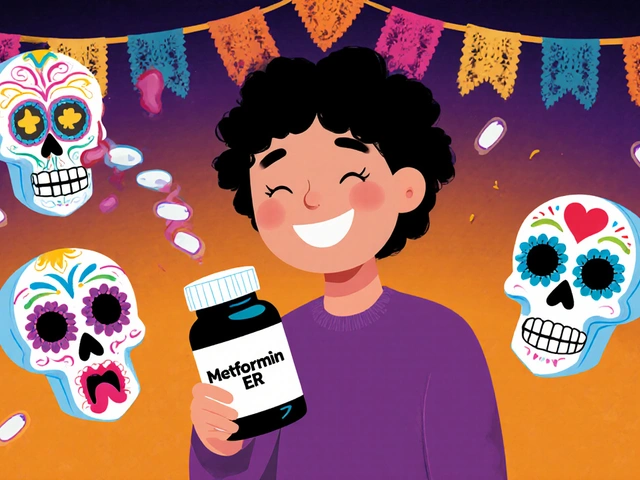Beta-Blocker & CCB Combination Safety Checker
Is Your Combination Safe?
This tool helps determine if your specific combination of beta-blocker and calcium channel blocker is safe based on the latest medical guidelines.
Why Doctors Sometimes Combine Beta-Blockers and Calcium Channel Blockers
When a single blood pressure medication isn’t enough, doctors often turn to combinations. One of the most common pairings is a beta-blocker with a calcium channel blocker. This combo works because the two drugs attack high blood pressure and heart strain from different angles. Beta-blockers slow your heart rate and reduce the force of each beat. Calcium channel blockers relax your blood vessels, making it easier for blood to flow. Together, they can lower blood pressure more effectively than either drug alone - especially in people with both hypertension and angina.
But this isn’t a one-size-fits-all solution. The risks can be serious - and not all calcium channel blockers are created equal. Mixing a beta-blocker with the wrong type of calcium channel blocker can slow your heart too much, trigger dangerous heart blocks, or even worsen heart failure. Knowing which combo is safe and which is risky can make the difference between better health and a hospital visit.
The Two Types of Calcium Channel Blockers - and Why It Matters
Not all calcium channel blockers are the same. There are two main groups, and mixing them with beta-blockers has very different outcomes.
Dihydropyridines - like amlodipine, nifedipine, and felodipine - mostly relax blood vessels. They don’t slow your heart much on their own. That’s why combining them with beta-blockers is generally safe. In fact, studies show this pairing lowers blood pressure effectively without major heart risks. In a 2023 study of nearly 19,000 patients, those on beta-blocker + amlodipine had fewer heart attacks, strokes, and hospitalizations for heart failure than people on other combinations.
Non-dihydropyridines - like verapamil and diltiazem - are different. They don’t just relax blood vessels. They also directly slow down the heart’s electrical system. When you add a beta-blocker to these, you’re stacking two drugs that suppress heart rate and conduction. The result? A dangerous drop in heart rate, prolonged PR intervals on an ECG, and sometimes complete heart block. One study found that 10-15% of patients on verapamil plus a beta-blocker developed high-grade heart block requiring a pacemaker. That’s not a rare side effect - it’s a predictable one.
Who Should Avoid This Combination?
Some people should never get this combo. The guidelines are clear: if you have certain heart conditions, the risks outweigh the benefits.
- People with sinus node dysfunction - your heart’s natural pacemaker already struggles to keep a steady rhythm.
- Those with a PR interval over 200 milliseconds on their ECG - this means the signal from your atria to your ventricles is already delayed.
- Patients with second- or third-degree heart block - these are serious conduction problems that can lead to fainting or cardiac arrest.
- Anyone with heart failure with reduced ejection fraction - especially if it’s below 45%. Adding verapamil or diltiazem can make the heart pump even weaker.
- Older adults over 65 - their hearts are more sensitive to these effects, and drug metabolism slows with age.
Doctors check for these red flags before prescribing. A baseline ECG and echocardiogram aren’t optional - they’re mandatory. Skipping them is like driving blindfolded.

The Real-World Risks: What Happens When Things Go Wrong
It’s not just theory. Real patients have been hurt by this combo.
A cardiologist on Reddit shared a case: an 82-year-old man was started on metoprolol for high blood pressure. His doctor added verapamil a week later because his pressure wasn’t down. Within days, he collapsed. His ECG showed complete heart block. He needed an emergency pacemaker. He survived - but barely.
Another study found that patients on beta-blocker + verapamil were 3.2 times more likely to need a pacemaker than those on beta-blocker + amlodipine. The risk of hospitalization for heart failure was nearly three times higher. And it’s not just older patients - younger people with undiagnosed conduction problems are also at risk. One study found that 15% of people over 75 had hidden heart block that wasn’t caught until after they were started on this combo.
Side effects aren’t just about heart rate. Peripheral edema - swelling in the ankles - is common with dihydropyridines like amlodipine. About 22% of patients get it, compared to 16% on other combos. It’s usually mild, but it can be annoying enough that 18.7% of people on verapamil + beta-blocker quit the medication - compared to just 8.1% on amlodipine + beta-blocker.
When This Combo Actually Helps - and Who Benefits Most
Despite the risks, this combination has real value for the right people.
If you have high blood pressure plus chest pain (angina), beta-blockers and calcium channel blockers together can be first-line therapy. They reduce the heart’s demand for oxygen and improve blood flow. Studies show patients on this combo can exercise 90-120 seconds longer without chest pain than on either drug alone.
It’s also effective for certain arrhythmias, like atrial fibrillation with rapid ventricular response. Beta-blockers slow the heart rate, and non-dihydropyridine CCBs help control rhythm. But even here, doctors avoid verapamil in patients with heart failure or conduction issues.
For people with resting heart rates above 80 beats per minute, beta-blockers are especially useful. They don’t just lower blood pressure - they reduce long-term heart damage. The European guidelines recommend beta-blockers specifically for this group, and pairing them with amlodipine is a solid strategy.

What Doctors Do Before and After Prescribing
This isn’t a prescription you get and forget. There’s a process.
Before starting:
- Get an ECG - check your PR interval and look for signs of hidden heart block.
- Have an echocardiogram - measure your ejection fraction. If it’s below 45%, avoid non-dihydropyridines.
- Review all your other meds - especially other heart drugs. Verapamil can increase beta-blocker levels by 20-30% in some people.
After starting:
- Check your pulse weekly for the first month. If it drops below 50 bpm, call your doctor.
- Watch for dizziness, fainting, or swelling in your legs.
- Return for a follow-up ECG in 2-4 weeks.
Many clinics now use risk calculators - like the one from the European Society of Cardiology - to predict who’s most likely to develop bradycardia. These tools are 89% accurate and help avoid dangerous surprises.
What’s the Bottom Line?
Combining beta-blockers and calcium channel blockers isn’t inherently bad - but it’s not a casual choice either.
Safe combo: Beta-blocker + amlodipine (or other dihydropyridine). Good for hypertension, angina, and patients with high resting heart rate. Low risk of heart block. Watch for ankle swelling.
Unsafe combo: Beta-blocker + verapamil or diltiazem. High risk of dangerous bradycardia and heart block. Avoid in anyone over 65, anyone with conduction problems, or anyone with heart failure.
Most doctors now avoid verapamil with beta-blockers unless there’s no other option. A 2022 survey of over 1,200 clinicians found only 12% would consider this combo even in select cases. The rest prefer amlodipine - and for good reason.
If you’re on this combo, ask your doctor: Which type of calcium channel blocker am I taking? Is my ECG normal? Is my heart pumping well? Don’t assume it’s safe just because two common drugs are being used together. The interaction is subtle - but the consequences aren’t.
What’s Changing in 2025?
Guidelines are tightening. The European Society of Hypertension is rolling out a new risk-stratification tool in early 2025 - designed to predict who can safely take this combo based on age, ECG, kidney function, and other factors. It’s already being tested in clinics across Europe.
Meanwhile, prescriptions for beta-blocker + verapamil are falling. In the U.S., they’ve dropped by 18% since 2020. Amlodipine-based combos are rising. The trend is clear: safety is winning over convenience.
For patients, this means better outcomes - fewer hospitalizations, fewer pacemakers, and more confidence that the treatment they’re on won’t hurt them as much as it helps.
Can I take a beta-blocker and calcium channel blocker together?
Yes - but only under strict conditions. Beta-blockers can safely be combined with dihydropyridine calcium channel blockers like amlodipine. This combo is often used for high blood pressure and angina. However, combining beta-blockers with non-dihydropyridines like verapamil or diltiazem is dangerous for many people and can cause slow heart rate, heart block, or heart failure. Always get an ECG and echocardiogram before starting this combo.
What’s the difference between amlodipine and verapamil?
Amlodipine is a dihydropyridine calcium channel blocker that mainly relaxes blood vessels, with little effect on heart rate or rhythm. Verapamil is a non-dihydropyridine that slows the heart’s electrical system and reduces its pumping strength. When combined with a beta-blocker, amlodipine is safe for most people; verapamil can cause life-threatening heart block.
Is this combo safe for older adults?
It depends. Beta-blocker + amlodipine can be safe for older adults with high blood pressure and no heart block. But beta-blocker + verapamil or diltiazem is strongly discouraged in patients over 65. Their hearts are more sensitive, and hidden conduction problems are common. Studies show a 3.2-fold higher risk of needing a pacemaker with this combo in seniors.
What are the warning signs this combo is too strong?
Watch for: heart rate below 50 bpm, dizziness, fainting, extreme fatigue, shortness of breath, or swelling in your ankles. If you feel your heart skipping or slowing down, get an ECG right away. These aren’t normal side effects - they’re red flags for dangerous heart block.
Do I need to get blood tests before starting this combo?
Blood tests aren’t the main concern - heart tests are. You need an ECG to check your PR interval and rule out hidden heart block. An echocardiogram is needed to measure your ejection fraction. If your heart’s pumping ability is below 45%, avoid verapamil or diltiazem. Kidney and liver function tests may be done if you’re on multiple meds, but the real risk is in your heart’s electrical system - not your blood.










